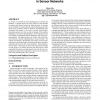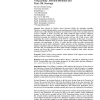367 search results - page 18 / 74 » Self-Organization in Sensor Networks using Bio-Inspired Mech... |
WISEC
2010
ACM
13 years 5 months ago
2010
ACM
As sensors in a network are mostly homogeneous in software and hardware, a captured sensor can easily expose its code and data to attackers and further threaten the whole network....
IJSNET
2010
13 years 6 months ago
2010
: Data collected by Wireless Sensor Networks (WSNs) are inherently unreliable. Therefore, to ensure high data quality, secure monitoring, and reliable detection of interesting and ...
HOTOS
2009
IEEE
13 years 11 months ago
2009
IEEE
This paper makes the case that operating system designs for sensor networks should focus on the coordination of resource management decisions across the network, rather than merel...
SAINT
2008
IEEE
14 years 1 months ago
2008
IEEE
The utility of walking parameters such as stride length, cadence and gait velocity for monitoring motor functions of patients suffering from brain injury, Parkinson’s disease an...
VTC
2007
IEEE
14 years 1 months ago
2007
IEEE
— This paper investigates the topology formation mechanisms provided by IEEE 802.15.4 to create tree-based topologies, in the context of a multi-sink wireless sensor network. The...


